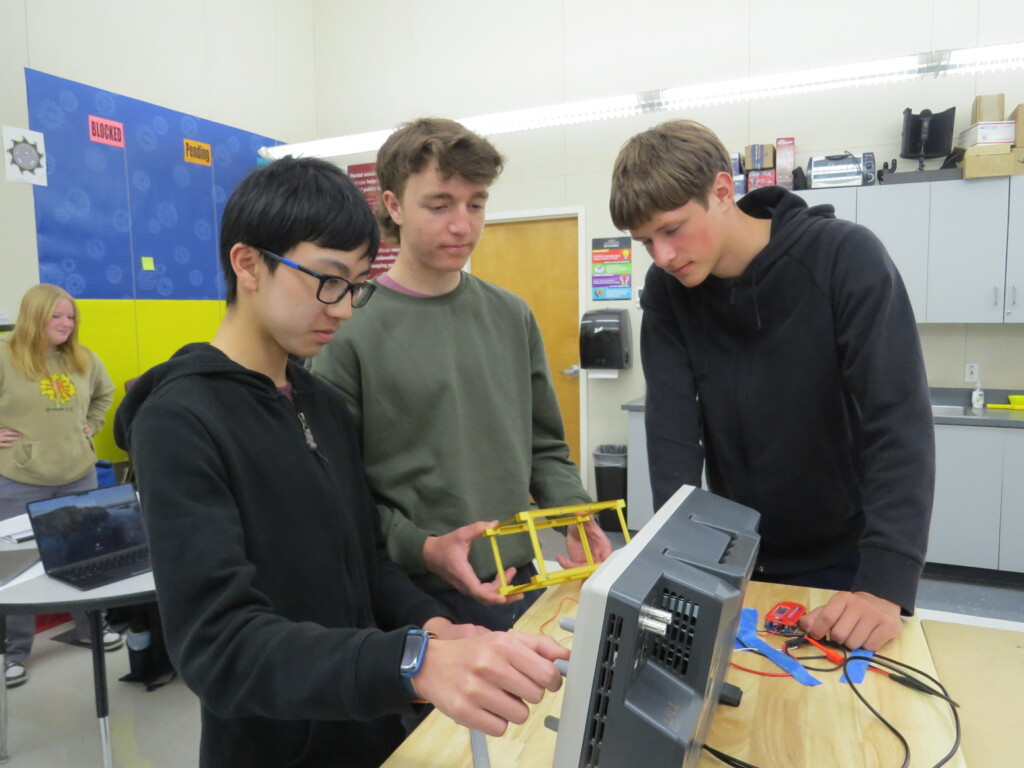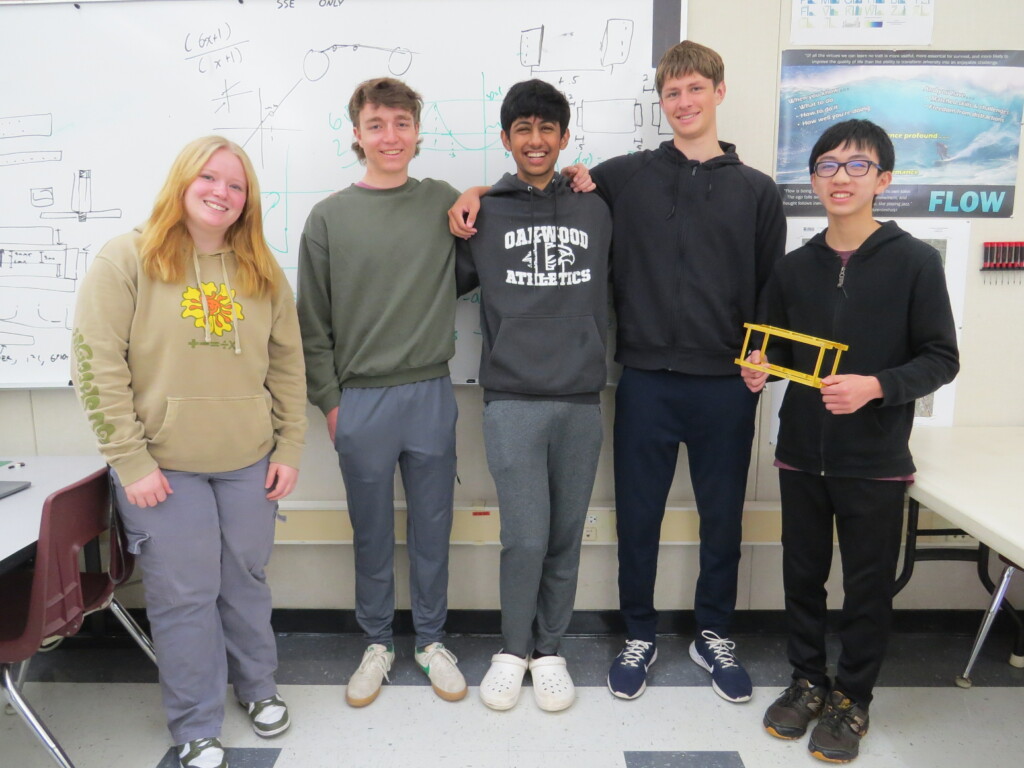Education: Students reach for the stars with NASA project
Oakwood School team designed “CubeSat” to launch in three years

Oakwood students Kayden Wang, Dillon Hall, and Porter Banks work on their NyanSat that will be part of NASA’s CubeSat Launch Initiative, the only non-university that is part of the program. Photo by Mikaela Minoza
By Mikaela Minoza
It’s “three . . . two . . . one . . . blastoff!” for five Oakwood School students as they celebrate NASA selecting their miniature satellite project to be sent to the International Space Station for the agency’s CubeSat Launch Initiative.

Photo by Mikaela Minoza
What makes this accomplishment even more stellar is that Oakwood stands as the only high school in America selected for this mission. The Morgan Hill private school joins eight universities and a NASA center. NASA’s CubeSat Launch Initiative’s goal is to inspire the next generation of scientists through educational outreach. That is exactly what students in the Spacecraft Systems Engineering class have in mind with the design of their satellite.
NASA announced in mid-March it selected 10 small research satellites, called CubeSats. NyanSat is a nanosatellite designed and built by an Oakwood class. It will serve as an example for educational outreach and space technology development. It will hold several payloads that will test and demonstrate how well various new systems work in space. These include:
- An acoustic spacecraft mapping and sounding payload, which aims to simplify sensor systems in spacecraft and provide additional mission information.
- A cryptographic ledgers in space payload, which will test the possibility of using space-based digital notaries for transactions on Earth and in space.
CubeSats are small, cube-shaped satellites that follow a standard size. The basic unit, called 1U, measures 10 x 10 x 11 centimeters. CubeSats can be made bigger by combining multiple units, up to a size of 12U.
Because CubeSats are small and inexpensive to build and launch, they make it easier for different organizations, like government agencies, companies, and universities, to work together on space projects. CubeSats also allow for quick development and provide an affordable way to conduct scientific research and test new technologies in space.

Photo by Mikaela Minoza
NyanSat’s volume is two units, giving students enough room so they could compose an ambitious project, said Spacecraft Systems Engineering class instructor Michael Lyle.
In preparation for the launch sometime in the next two years, Oakwood junior Lauren Sorci and sophomores Dillon Hall and Kayden Wang work on CubeSat’s structure. Senior Ruchir Kavulli works on the design of the on-board computer that will orchestrate the spacecraft’s actions and communicate with the ground.
Lyle provided the students with materials and advice on the size and process of the CubeSat.
“All the payload choices and all the design choices have been very much student-driven,” he said.
The payload’s scientific and technological instruments will help carry out the intended missions. Oakwood sophomore Dillon Hall serves on the mechanical structure team. He described the research goal of the NyanSat project.
“We are going to put a bunch of semiconductors in space, different materials, and see how they react to being in space,” he said. “And then we’re going to send out a bunch of control experiments to about 30 disadvantaged schools across the country. And then they get to run their control experiment, and see and compare it to what we’re seeing on the satellite.”
Hall explained technology development is a primary focus of NASA’s nanosatellite program. With NyanSat, four new technologies will first be validated and then sent into orbit to test if they are ready for the harsh conditions of space. One of NyanSat’s goals is to test acoustic spacecraft mapping and sounding, he said.

Photo by Mikaela Minoza
“We also have a bunch of different technology demonstrations. We’re trying out a new technology called acoustic mapping,” he said. “We are going to try and see the status of our satellite in space. One example is to see if some of our solar panels have deployed or not.”
Senior Shrihan Dash and freshman Porter Banks are designing these solar panel assemblies, which will envelop the exterior of the satellite. Stepping into his first year of working on the satellite, Banks expressed excitement at NyanSat being selected by NASA. He’s proud of his contributions to the design element of the satellite.
“We are finding digital footprints for a bunch of things right now,” Banks said. “I’m working on getting the optimal voltage and all the details concerning the solar panel design and structure.”
An important component of NASA’s program is the educational outreach aspect of the project for older students and raising awareness and interest within the realm of space science and technology, Banks said.
“We’re using this project to really draw awareness to it,” he said. “We are also going to be helping underdeveloped schools by giving them materials that could help them with developing programs like this themselves.”
Sophomore Kayden Wang joined the spacecraft club last year. He plays a critical role in the spacecraft system engineering aspect of NyanSat.
“I’ve worked on equations for the structural integrity of the frame of the spacecraft,” he said.
Wang felt excited when he heard Oakwood’s engineering class project had been selected by NASA.
“We didn’t expect to be this fortunate to be accepted to launch our satellite,” he said. “I think it’s cool I’ll be able to work on this through my time in high school.”
As a sophomore, Kayden will be able to execute the project to the end.
If all goes according to plan, the timeline consists of wrapping up the design this school year, constructing it next year, and using radio signals to communicate with the satellite in orbit the following year, Lyle said.
There are two main goals within the education outreach program. The first one focuses on providing opportunities for disadvantaged students to run control experiments and compare them to what the satellite is actually doing in space.
Extending this opportunity to young students not only inspires a new generation of scientists but also demonstrates to young minds that, literally, the sky is not the limit, he said.
 Emerging as the only high school selected by NASA for this mission with a student-driven project serves as a testament to Oakwood’s science and engineering program, Lyle said. The recognition opens a door of opportunities for the current team as well as all of the incoming students who will join this program after being inspired by the progress already made, he said.
Emerging as the only high school selected by NASA for this mission with a student-driven project serves as a testament to Oakwood’s science and engineering program, Lyle said. The recognition opens a door of opportunities for the current team as well as all of the incoming students who will join this program after being inspired by the progress already made, he said.
The team’s focus on educational outreach will go beyond providing control experiments for disadvantaged students. The team intends to invite elementary school students to draw pictures to be sent into space.
“We are going to have a little canister on the side with a big ribbon of these drawings shrunk down, and it’s gonna pop open and unfold in space,” Lyle said. “Some number of days later, it’ll burn up as a shooting star.”
Mikaela Minoza is a senior at Oakwood High School. She wrote this story for Gilroy Life.
